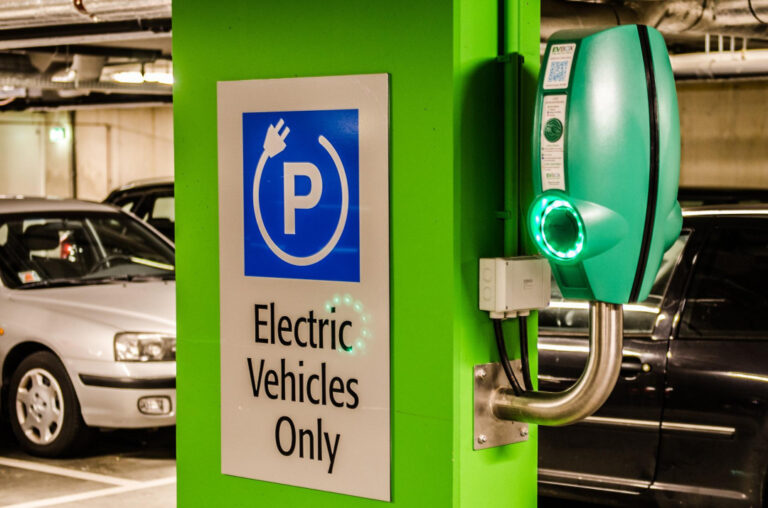
You may be eligible for a tax credit when you purchase a new qualifying vehicle that is a plug-in electric vehicle (PEV) that uses a traction battery with at least five kilowatt-hours (kWh) of capacity. The electric car uses an external source of energy, such as a home outlet or public charging station, to recharge the battery. With a gross vehicle weight rating of up to 14,000 pounds, the electric car is able to meet specified emission standards. This electric car tax credit can help offset the cost of your new PEV and make owning one more affordable for ev buyers. To take advantage of these tax incentives, be sure to keep documentation of the purchase of your new electric vehicle, such as a sales invoice or receipt showing the retail price, as well as any other required paperwork. The credit amount is based on the traction battery capacity and the gross vehicle weight rating. The minimum credit amount is $2,500, and the maximum credit amount is $7,500. The credit will begin to be phased out for each manufacturer in the second quarter following the calendar quarter once a manufacturer has sold at least 200,000 qualified PEVs for use in the United States. The federal government offers a new tax credit for certain fuel-efficient vehicles purchased after December 31, 2009.
Electric Cars Eligible for the Full $7,500 Tax Credit
- Audi e-tron GT – $7,500
- Audi RS e-tron – $7,500
- Audi e-tron – $7,500
- Audi e-tron Sportback – $7,500
- Audi Q4 e-tron – $7,500
- Audi Q4 Sportback e-tron – $7,500
- BMW i4 eDrive40 Gran Coupe – $7,500
- BMW i4 M50 Gran Coupe – $7,500
- BMW iX xDrive50 – $7,500
- Ford Mustang Mach-E – $7,500
- Ford E-Transit – $7,500
- All General Motors electric vehicles (Chevrolet, Cadillac) – No longer eligible for federal EV tax credits
- Hyundai Ioniq 5 – $7,500
- Hyundai Kona Electric – $7,500
- Jaguar I-Pace – $7,500
- Kia EV6 – $7,500
- Kia Niro EV – $7,500
- Lucid Air – $7,500
- Mazda MX-30 – $7,500 (full tax credit may not be available)
- Mercedes-Benz EQS – $7,500
- Mini Hardtop Electric – $7,500
- Nissan Leaf – $7,500
- Polestar 2 – $7,500
- Porsche Taycan – $7,500
- Porsche Taycan Cross Turismo – $7,500
- Porsche Taycan Sport Turismo – $7,500
- Rivian R1T – $7,500
- Rivian R1S – $7,500
- All new Tesla models – No longer eligible for federal EV tax credits
- Volkswagen ID.4 – $7,500
- Volvo XC40 Recharge – $7,500
Plug-in Hybrid Vehicles Eligible for the Tax Credit
- Audi A7 Plug-in Hybrid – $7,500
- Audi Q5 Plug-in Hybrid – $7,500
- Bentley Bentayga Plug-in Hybrid – $7,500
- BMW X5 Plug-in Hybrid – $7,500
- BMW 3 Series Plug-in Hybrid – $5,836
- BMW 5 Series Plug-in Hybrid – $5,836
- BMW 7 Series Plug-in Hybrid – $5,836
- Chrysler Pacifica Plug-in Hybrid – $7,500
- Ford Escape Plug-in Hybrid – $6,843
- Hyundai Ioniq Plug-in – $4,543
- Hyundai Tucson Plug-in – $6,857
- Hyundai Santa Fe Plug-in – $6,857
- Jeep Wrangler 4xe – $7,500
- Jeep Grand Cherokee 4xe – $7,500
- Kia Niro Plug-in Hybrid – $4,543
- Kia Sorento Plug-in Hybrid – $6,857
- Land Rover Range Rover Plug-in Hybrid – $6,295
- Lexus NX 450h+ – $7,500
- Lincoln Aviator Plug-in Hybrid – $6,534
- Lincoln Corsair Plug-in Hybrid – $6,843
- Mini Countryman Plug-in Hybrid – $5,002
- Mitsubishi Outlander PHEV – $6,587
- Polestar 1 (Discontinued for 2022) – $7,500
- Porsche Cayenne Plug-in Hybrid – $7,500
- Porsche Panamera Plug-in Hybrid – $7,500
- Subaru Crosstrek Plug-in Hybrid – $4,502
- Toyota Prius Prime – $4,502
- Toyota RAV4 Prime – $7,500
- Volvo S60 Plug-in Hybrid – $5,419
- Volvo S60 Plug-in Hybrid (Extended Range) – $7,500
- Volvo S90 Plug-in Hybrid – $5,419
- Volvo S90 Plug-in Hybrid (Extended Range) – $7,500
- Volvo V60 Plug-in Hybrid – $5,419
- Volvo V60 Plug-in Hybrid (Extended Range) – $7,500
- Volvo XC60 Plug-in Hybrid – $5,419
- Volvo XC60 Plug-in Hybrid (Extended Range) – $5,419
- Volvo XC90 Plug-in Hybrid – $5,419
- Volvo XC90 Plug-in Hybrid (Extended Range) -$7,500
If you’re wondering why Teslas or the GMC Hummer EV are not eligible vehicles for a $7,500 federal tax credit, it’s because GM and Tesla have each sold over 200,000 eligible electric vehicles. All of its federal tax credits have been phased out. When a manufacturer sells its 200,000th qualified vehicle, the tax ev credit is scheduled to wind down. This reduction will happen over time, with the tax credit being cut in half to $3,750 and then being cut in half again. Eventually, the tax credit will be reduced to nothing. While there may not be a federal incentive, there are still state incentives available for buying a Tesla or GM, so it’s definitely worth checking with your state government’s department of transportation to see if you qualify.
In 2018, Tesla sold its 200,000th vehicle, fully exhausting the available tax credit by the end of 2019. Two other popular EVs, the Chevrolet Bolt EV, and the larger Bolt EUV, also are no longer eligible for any tax credit as of 2020.
The U.S. Department of Energy and the Internal Revenue Service (IRS) maintain a list of vehicles eligible EVs for lower tax credits. You can find the full list of eligible EVs on the Department of Energy website and another list on the IRS website.
I don’t know how to get the federal EV tax credit.
In order to claim the federal income tax credit for an electric vehicle of up to $7,500, you must first purchase a new and eligible EV. After making your purchase, you will need to fill out IRS Form 8936 in order to claim your credit.
Why Do You Keep Saying “Up To”?
The qualified plug-in electric drive motor vehicle credit is a nonrefundable federal tax credit of up to $7,500, which requires taxpayer eligibility. Jackie Perlman, principal tax research analyst at H&R Block’s Tax Institute explains that this credit can help offset the cost of purchasing a qualifying new electric car. The credit you receive will lower your tax liability dollar for dollar. Your tax liability is the amount of taxes that are calculated based on your net taxable income. If the credit you receive is more than what your tax liability is, you will not get the remainder of the credit.
In other words, if you owe $4,000 in taxes before applying for the $7,500 credit, your tax bill will be reduced to $0. However, you won’t receive the additional $3,500. The non-refundable tax credit can’t directly increase your tax refunds or reduce your tax liability, but it could lead to a higher tax return. It’s always a good idea to consult with a tax professional, especially when you’re trying to figure out how a tax credit will apply to your specific financial and filing situation. That way, you can be sure that you’re taking advantage of every possible deduction or credit.
How Much Do I Need to Make to Have a $7,500 Tax Liability?
We checked with the professionals about this, too. Mark Steber, chief tax information officer at Jackson Hewitt, has stated that single filers will need an income of $65,964 in 2021 in order to have the full credit of $7,500 in tax liability. This is a slight increase from the amount required in 2020, which was $65,627. These figures assume that only a standard deduction is taken and no other credits are applied. If you’re a head of household filer, you would need to have made $78,818 in 2021 in order to qualify, which is up from $78,432 in 2020. For married couples filing jointly, the combined income caps of both spouses would need to be $90,920 in 2021, which is also up from $90,592 in 2020. However, as always, it’s best to consult with a tax professional about your specific filing situation.
Are there any other credits?
Vehicle incentives are typically offered at the state and local levels, though the types of vehicles eligible and the amount of the incentive may vary. A list of state vehicle incentives can be found here.
How about used EVs?
There may be state or other local incentives that apply to the purchase of a used EV, but the federal EV tax credit does not. This is because the credit is only available for new EVs.
Can I get federal credit if I only lease a new EV?
The tax break only applies to electric new cars. The lessee, however, may receive the savings in the form of a lower monthly payment. In other words, the credit cannot be applied to leased EVs, but the lessee may see benefits in the form of reduced monthly payments.
Are Any Other Manufacturers in the Auto Industry Close to Having the Credit Phase Out?
In July, Toyota hit the mark and removed the RAV4 Prime, bZ4X, and other subsequent Toyotas from eligibility for the electric vehicle tax credit. This means that these models will no longer be able to receive government incentives. Nissan is the next closest manufacturer to Tesla in terms of vehicles sold, but it is unlikely that they will reach the 200,000 vehicles sold threshold for several years. The introduction of their upcoming all-electric Ariya SUV may help to accelerate that timeline; Ford also increased its EV production this year. Volvo and Volkswagen are both making an aggressive push to electrify their lineups; however, both are significantly far away from selling 200,000 qualifying vehicles.
Should You Bank on the EV Tax Credit?
According to Steber, the federal EV tax credit can be a significant benefit, but shoppers shouldn’t make their decision to buy new vehicles that are electric based solely on this incentive. Anyone considering an electric vehicle should do their research to fully understand all the costs and stipulations of available benefits in comparison to the purchase price.



